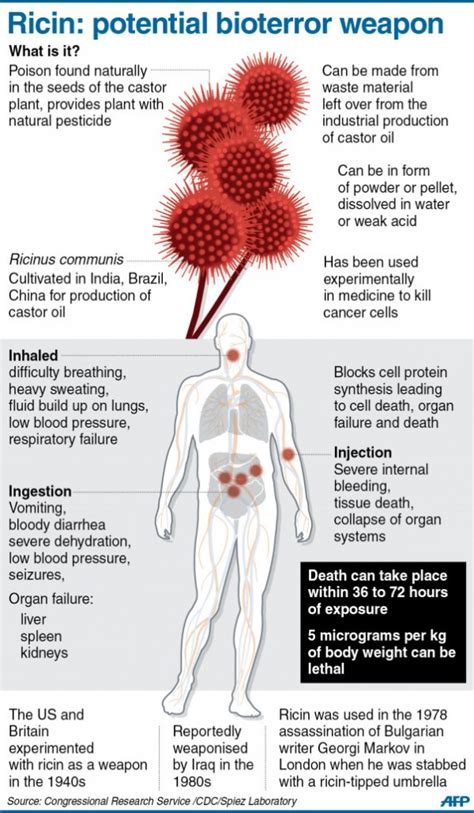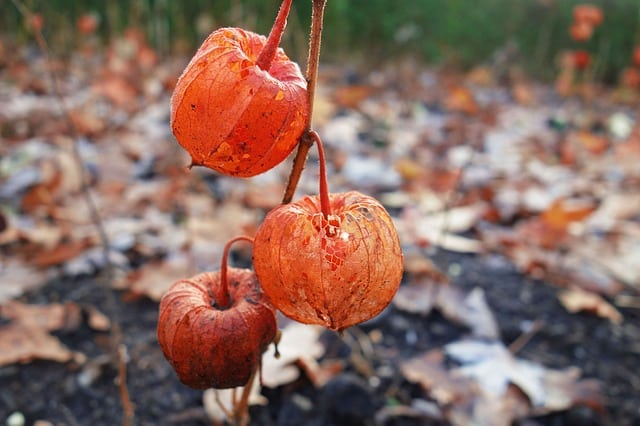
Ricin Poisoning
What is Ricin poisoning?
Ricin poisoning is a serious condition caused by the ingestion, inhalation, or injection of ricin, a highly toxic protein. Ricin is derived from the castor bean plant, which is found in many parts of the world. Although ricin can be deadly, it is important to note that it is not easily spread from person to person. In this blog post, we will explore the details of ricin poisoning, including its symptoms, methods of diagnosis, treatment options, and preventive measures.
Ricin poisoning can occur when ricin enters the body through ingestion, inhalation, or injection. Ingestion is the most common route of exposure, typically through the consumption of castor beans or products made from them. Inhalation occurs when individuals inhale ricin powder or the aerosolized form of the toxin. Injection is the least common route and usually results from intentional poisoning or accidental needlestick injuries. It is important to note that even a small amount of ricin can cause severe toxicity.
The symptoms of ricin poisoning can vary depending on the route of exposure. Common symptoms include nausea, vomiting, abdominal pain, diarrhea, and dehydration. In severe cases, individuals may experience organ failure, seizures, difficulty breathing, and even death. It is crucial to seek medical attention immediately if you suspect ricin poisoning.
Symptoms of Ricin poisoning
When it comes to Ricin poisoning, it is important to be aware of the symptoms that may arise. Ricin is a highly toxic substance that is derived from the castor bean plant. It can be found in various forms such as powder, mist, or even as a pellet. The symptoms of Ricin poisoning can vary depending on the route of exposure, whether it be through inhalation, ingestion, or injection.
One of the most common symptoms of Ricin poisoning is respiratory distress. This can include coughing, shortness of breath, and chest tightness. If inhaled, Ricin can cause irritation and inflammation in the lungs, leading to difficulty in breathing. In severe cases, it may even cause respiratory failure, which can be life-threatening.
In addition to respiratory symptoms, Ricin poisoning can also affect the gastrointestinal system. This can result in nausea, vomiting, abdominal pain, and diarrhea. These symptoms typically occur when Ricin is ingested, either intentionally or accidentally.
Another symptom of Ricin poisoning is fever. This is associated with the body’s response to the toxin and can be accompanied by chills and sweating. The severity and duration of the fever can vary depending on the amount of Ricin exposure and individual factors.
- Coughing
- Shortness of breath
- Chest tightness
- Nausea
- Vomiting
- Abdominal pain
- Diarrhea
- Fever
- Chills
- Sweating
It is important to note that the onset of symptoms may vary depending on the dose and route of exposure. Some individuals may experience symptoms within a few hours, while others may not show any signs for several days. Therefore, it is crucial to seek medical attention immediately if Ricin poisoning is suspected.
| Symptoms of Ricin poisoning | Route of Exposure |
|---|---|
| Coughing, Shortness of breath, Chest tightness | Inhalation |
| Nausea, Vomiting, Abdominal pain, Diarrhea | Ingestion |
| Fever, Chills, Sweating | Varied |
In conclusion, being aware of the symptoms of Ricin poisoning is crucial in order to seek immediate medical help. Whether it be respiratory distress, gastrointestinal issues, or fever, recognizing these signs can aid in prompt diagnosis and treatment. It is important to remember that Ricin is a highly toxic substance, and any suspicion of exposure should be taken seriously.
Methods of Ricin poisoning diagnosis
When it comes to diagnosing Ricin poisoning, there are several methods that healthcare professionals can employ. These diagnostic techniques are crucial in determining the presence of Ricin in the body, allowing for timely treatment and intervention.
One of the common methods used for diagnosing Ricin poisoning is blood tests. Through a simple blood sample, healthcare providers can detect the presence of Ricin in the bloodstream. This is typically done by analyzing the antibodies or toxins present in the blood sample. If elevated levels of Ricin or related toxins are found, it indicates a positive diagnosis of Ricin poisoning.
In addition to blood tests, urine tests can also be employed as a diagnostic method for Ricin poisoning. Similar to blood tests, healthcare professionals analyze the urine sample for the presence of Ricin or its toxins. This method is effective in identifying Ricin exposure and can be especially useful in cases where blood testing may not provide conclusive results.
Furthermore, imaging techniques, such as radiography or computed tomography (CT) scans, can be used to diagnose Ricin poisoning. These imaging modalities help healthcare providers assess the extent of organ damage or abnormalities caused by Ricin exposure. By visualizing the affected organs, doctors can better understand the impact of Ricin on the body and develop appropriate treatment plans.
Overall, the diagnostic methods for Ricin poisoning play a crucial role in identifying and treating this dangerous condition. Blood tests, urine tests, and imaging techniques provide valuable insights into the presence of Ricin and its effects on the body. Detecting Ricin poisoning accurately allows healthcare professionals to provide prompt and effective treatment, improving the chances of a successful recovery for the affected individuals.
Treatment options for Ricin poisoning
Ricin poisoning is a serious condition that occurs when a person is exposed to or ingests ricin, a highly toxic substance derived from the seeds of the castor oil plant. It is considered a potent toxin and can be deadly even in small amounts. Ricin works by disrupting the normal functioning of cells, leading to organ failure and ultimately death if not treated promptly. In this blog post, we will discuss the various treatment options available for ricin poisoning and how they can help alleviate the symptoms and prevent further complications.
When dealing with ricin poisoning, prompt medical attention is crucial. The first step in treatment involves decontamination. This includes removing any clothing or material that may have come into contact with ricin and thoroughly washing the affected area with soap and water. It is important to avoid spreading the toxin to other parts of the body or to other individuals.
Supportive care is another important aspect of treating ricin poisoning. This involves managing and alleviating the symptoms associated with the condition. For instance, if a person experiences respiratory distress, they may be given supplemental oxygen or a ventilator to help with breathing. Similarly, fluids and medications may be administered intravenously to maintain hydration and stabilize blood pressure.
In severe cases of ricin poisoning, antitoxin therapy may be employed. Antitoxins are substances that can neutralize the effects of ricin in the body. These antitoxins are typically produced using animal models and can help mitigate the damage caused by the toxin. However, it’s important to note that antitoxin availability may be limited, and its effectiveness can vary depending on the timing of administration.
In summary, when it comes to treating ricin poisoning, decontamination, supportive care, and antitoxin therapy are the key treatment options available. However, it is crucial to remember that prevention is always better than cure. Taking necessary precautions to avoid ricin exposure, such as wearing protective clothing and handling substances with caution, can go a long way in preventing ricin poisoning.
Preventing Ricin poisoning
Preventing Ricin Poisoning
Ricin poisoning is a serious and potentially deadly condition caused by exposure to the toxin ricin. As there is no specific antidote or treatment available for ricin poisoning, it is crucial to focus on prevention strategies to avoid accidental or intentional ingestion of this dangerous substance. By following certain precautions and implementing preventive measures, we can significantly reduce the risk of ricin poisoning.
1. Awareness is Key: Educate yourself and others about ricin poisoning, its sources, and potential risks. Stay informed about any ongoing threats or incidents related to ricin exposure in your area.
2. Be Cautious with Suspicious Packages: If you receive an unexpected package or letter with unknown contents, exercise caution. Don’t open it and avoid handling it unnecessarily. Immediately notify the appropriate authorities or contact a bomb squad if you suspect the package contains ricin or any other hazardous substance.
3. Handle Food and Drinks with Care: Pay attention to the safety and quality of the food and drinks you consume. Avoid consuming food or beverages from untrusted sources, especially if you suspect tampering. If you notice any suspicious odor, taste, or appearance in your food or drink, discard it immediately.
- 4. Protect Yourself in High-Risk Environments: If you work in a high-risk environment where ricin or ricin-containing substances are handled (such as research facilities or laboratories), ensure you follow strict safety protocols. Use appropriate personal protective equipment (PPE), such as gloves and masks, and undergo proper training on handling hazardous materials.
- 5. Secure and Store Hazardous Materials: If you possess or work with potentially dangerous substances like castor beans or ricin, store them securely in locked containers or cabinets. Keep these materials away from the reach of children, pets, or unauthorized individuals.
- 6. Dispose of Hazardous Waste Correctly: Properly dispose of any hazardous waste, including ricin or ricin-contaminated materials. Follow local regulations and guidelines on waste disposal to prevent accidental exposure or environmental contamination.
By adopting these precautionary measures and practicing vigilance in our day-to-day activities, we can significantly reduce the risk of ricin poisoning. Remember, prevention is always better than cure when it comes to dealing with potentially life-threatening toxins like ricin.
Frequently Asked Questions
What is Ricin poisoning?
Ricin poisoning is a rare but potentially life-threatening condition caused by exposure or ingestion of ricin, a toxic protein derived from the castor bean plant.
What are the symptoms of Ricin poisoning?
The symptoms of Ricin poisoning can vary depending on the route of exposure, but common symptoms include fever, cough, chest tightness, difficulty breathing, nausea, vomiting, abdominal pain, diarrhea, and muscle pain.
What are the methods of Ricin poisoning diagnosis?
Ricin poisoning can be diagnosed through various methods, including blood and urine tests, identifying the presence of ricin in samples, and assessing symptoms and medical history. Imaging tests may also be conducted to evaluate organ damage.
What are the treatment options for Ricin poisoning?
There is no specific antidote for Ricin poisoning. Treatment mainly involves supportive care, such as ensuring proper oxygen supply, respiratory support, intravenous fluids, and treatment of specific symptoms. The affected individual may require hospitalization and close monitoring.
How can one prevent Ricin poisoning?
Preventing Ricin poisoning involves avoiding exposure to ricin. This can be achieved by properly handling and disposing of castor beans and avoiding consuming homemade concoctions or products made from castor beans unless from a reputable source. Increasing awareness about potential sources of ricin and practicing good hygiene can also help prevent poisoning.
What are the long-term effects of Ricin poisoning?
The long-term effects of Ricin poisoning can vary depending on the extent and severity of the exposure. In severe cases, it can lead to permanent organ damage or even death. Individuals who have survived ricin poisoning may experience lingering respiratory, gastrointestinal, or neurological issues.
Is there a risk of Ricin poisoning as a bioterrorism threat?
Yes, ricin has been considered a potential bioterrorism agent due to its high toxicity. It can be synthesized and spread as a powder or aerosol, making it a concern for public safety. However, measures are in place to prevent such incidents, and the risk remains relatively low.


